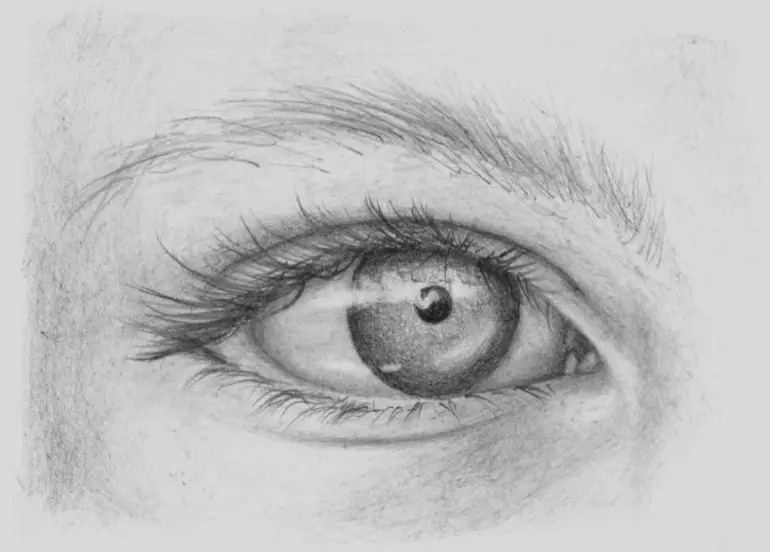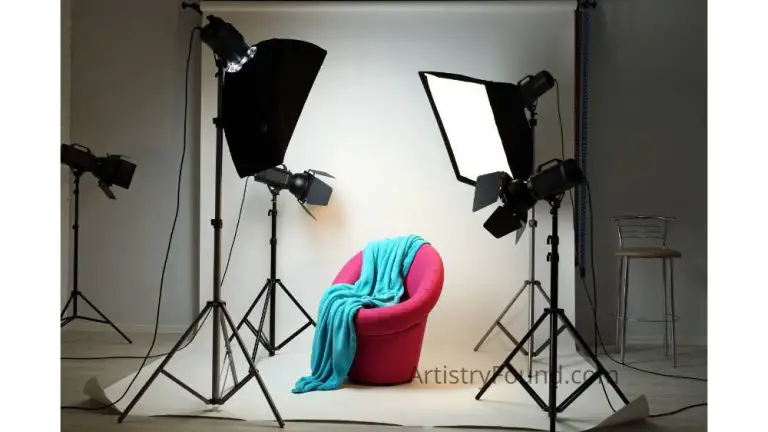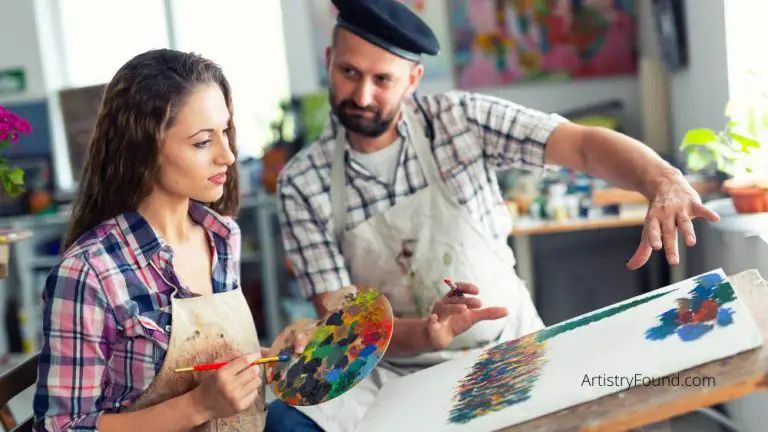Art School vs. Self Taught (The Complete Pros and Cons)
Becoming a professional artist takes a substantial amount of work and commitment, but it’s definitely possible. One of the biggest questions to ask yourself, however, is if you would rather get a formal education by going to art school or develop your skills by teaching yourself.
Attending art school vs. being self-taught are two very different methods to learn art. Art school allows for more experienced teachers as well as experience in the art world. On the other hand, being a self-taught artist allows for a more flexible curriculum and the freedom to make the art you want.

(This article may contain affiliate links and I may earn a commission if you make a purchase)
Making the decision to go to art school can be difficult. Should you go, or should you teach yourself. We will detail the pros and cons of art school vs self taught. Armed with the facts, you can weigh your options and make the best decision for you.
| Art School | Self-Taught | |
| Cost | Tuition for art schools is costly. You might have to take out a loan to pay for it, which can leave you in debt. | The cost of becoming a self-taught artist mainly has to do with paying for art supplies and studio spaces yourself. There are ways to save money on these necessities, but the expenses can rack up fast. |
| Opportunities | Art school can give you lots of opportunities to meet with people that can help you further your art career. They won’t come knocking at your door, but you will be closer to people that can give you opportunities to grow in the art world. | Being a self-taught artist has the potential to open lots of doors for you, but it’s a lot harder. Most people that can help with those opportunities usually don’t seek out independent artists. |
| Education Value | Art school is one of the best places you can go to further your skills and really develop your craft. The environment allows you to focus on your art and artwork only. | As a self-taught artist you can learn whatever skills you want whenever you want. You learn at your own pace and have the opportunity to take as much time as you need to perfect a skill. |
Pros of Attending an Art School
Going to art school and getting a formal education in the art medium of your choice can have many benefits that can make your career more fruitful down the line. It can also prove to be beneficial in more ways than just helping you improve as an artist.
Ability to Grow as a Person and an Artist
The main advantage of going to art school is that you’re in the ideal environment to grow as a person and as an artist. Art school forces you to push yourself and your talents, getting down to the nitty and the gritty of developing your craft. The main driving forces behind this are the teachers and other students.
All college professors are required to institute some amount of standards and expectations for their classrooms. Art professors are no different. They have a set number of deadlines and requirements that must be reached for assignments. Having to keep up with these responsibilities, as well as other responsibilities that college comes with, requires growth in time management skills and hard work.
Fortunately, teachers are also there to encourage you and help you with anything you’re struggling with on your way to becoming a trained artist. Experts in art are readily available for any questions you may have about the art world and developing your craft, or if you just want some feedback on your most recent project.
Aside from the academic aspect of art school, you will also meet a multitude of different people, all with their own unique styles and mindsets. This wider range of interaction can help you develop your ideas and artistic inspiration, perhaps making a few friends and building a support system along the way.
Easy Access to Materials and Studio Spaces
Art schools are designed to be used by, well, aspiring artists. Just like a regular college usually provides everything needed for their students’ success, art schools provide you with easy access to most materials and studio spaces.
Paying for your own artist space and materials can rack up fast, as will be explained further in the article. While art schools won’t provide everything, and definitely not for free, they provide easy access to everything you’ll need to grow your skills and inspiration. All you must do is know which buildings have which studio spaces and materials.
For example, one building would have spaces and materials for sculpting, while another would have the right areas and materials for painting. All of which are right in your backyard, so you can dedicate yourself to developing your craft and also experiment with other mediums.
Opportunity to Network and Find Job Opportunities
Another huge advantage of going to art school is that you have the opportunity to start networking and finding job and internship opportunities after graduation. You will also have a plethora of opportunities for exposure and to get your name as an artist out there.
Art professors are bound to have connections with prominent names in the art world, and they can be used as a direct line to exposure and the chance to have your art noticed. If you come across the chance to display your art in an exhibit or show that’s put on by your art school, that’s also a chance to get a head start on breaking out into the artistic world.
When it comes to finding jobs and internships, having a degree in an artistic medium is a fantastic way to make you stand out from the rest of the artistic pool. The difference between artists without a formal education and those with one is obvious to professional artists that have seen more than enough portfolios in their time.
If the time you spend in a formal art class is maximized, then it can push you several steps ahead of artists that declined to receive formal training. However, art school has its fair share of drawbacks that should be considered as well.
Recommended Reading: Do Art Schools Care About Grades? (What You Need To Know)
Cons of Attending an Art School
While art school provides many opportunities and advantages, there are important cons that should be taken into consideration before registering.
Being Held Back by Structure
Even though art school is a place that thrives off of free expression and creativity, it does still have a foundation of structure as most schools do. Because of this, you will have to play by someone else’s rules. They will dictate what kind of art you can create for a little while.
The structure of having to complete certain assignments within a specified amount of time can limit the amount of time you have to experiment with mediums and styles you enjoy. Some art teachers expect you to abide by the rules of style they have set in their classroom, which can cause you to deviate from what makes you unique as an artist.
Different learning styles might also not mix well with the teaching styles of certain art teachers. If an art teacher starts educating you in a way that doesn’t help you further your skills, artistic or academic, it can cause you to struggle and develop a negative attitude towards something you usually enjoy doing.
Finally, art school requires you to sacrifice expressing yourself for high marks on assignments, which may feel stifling and like you’re in a regular college. Once you graduate, of course, you can do whatever you’d like. But the years you spent bound by the structure of a learning environment can have detrimental effects on exploring your artistry.
Having to Start From The Beginning
In somewhat the same realm as being forced to conform to a structure, you will also probably have to be forced to start from the beginning. Art schools offer anyone, whether they are experienced artists or not, the opportunity to develop artistic skills. Because of this, they often force every single one of their students to start out their first couple of semesters by taking introductory art technique classes in a variety of mediums.
This can quickly start feeling like a waste of time if you entered art school as an experienced artist looking to develop your skills. The classes probably won’t be challenging enough for you and you might even experience some frustration at being knocked back to square one with everyone else.
Not Receiving the Education You Wanted
If you wanted to go to art school to get a better idea of how the business side of the art industry works, then you’ll likely end up being disappointed. Art schools allow for opportunities and network connections, yes, but they don’t usually focus on formally educating their students on how to conduct business in the art world.
The most you will probably be able to get is a few words of advice here and there. But other than that, you’re pretty much left on your own to figure it out. This can distract you from focusing on your skills and lead to confusion on how to make your craft your livelihood.
Art Schools are Incredibly Expensive
The main downside of going to art school is that it is incredibly expensive. Some schools are a little less expensive than others depending on size and location, but paying the tuition for a high quality art school can very likely leave you with a mountain of debt once you graduate.
The average cost of everything that comes with going to art school, from living expenses to academic fees, is between $35,000 and $39,000 per year. A few things that can affect the cost of art school are location and the type of degree you receive.
Art schools that are located in artistic hot spots, such as New York or Los Angeles, tend to be more expensive. This can be due to the high costs of living there that get added to the already steeply expensive tuition. It is true that you have easy access to a lot of materials and spaces to practice your craft, but it might not be worth it further down the road, especially if you take out loans or don’t have any scholarships to help you out.
Secondly, when you go to art school you can either study for a BFA (Bachelor of Fine Arts) or a BA (Bachelor of Arts). The main difference between these two degrees is that a BFA tends to focus on one medium of art, while a BA has a broader and more general range of art knowledge and skills.
When it comes to money, a BFA art degree is usually more expensive because of the longer amount of time you’ll need to spend in school. A BA is a little bit less expensive college degree but still has a high cost, and comes without the advanced knowledge of a BFA.
Even the more affordable art schools can prove to be very expensive. Deciding if they really are worth your time or not can mean going into debt without an easy way to get out of it or having the financial and personal freedom to explore your artistic expression.
If art school doesn’t sound like the right path for you, then taking the self teaching road might be the better option for developing your skills as an artist and yourself as a person.
Recommended Reading: Why Are Art Schools So Expensive? (Explained)
Pros of Being a Self-Taught Artist
The most popular alternative to getting a formal education at an art school is to teach yourself, also known as self-learning. Exactly as the name implies, you would be your own professor and spend time teaching yourself how to develop your craft.
You Are Always Learning at Your Own Pace
You are the boss of how fast you learn and how much you learn as an artist when you are self-taught. The lessons and projects you want to take on each day are all dependent on what you want to learn or how motivated you’re feeling.
A professor that usually doesn’t have a good idea of how you learn best or the art style you prefer is no longer able to base the development of your skills around a set schedule. The time constraints of a university or art school no longer apply to you, so you have the freedom to learn as much or as little as you want in a time frame that you decide.
And no matter how fast or slow paced your learning speed is, you will always be continuously learning. There aren’t any explicitly written rules you have to follow or requirements you have to reach in order to receive the title of artist. This also frees you from the prospect of having to work on skills that you aren’t particularly good at in the name of reaching a generalized set of skills.
Only Focusing on Your Chosen Medium
Being a self taught artist means that you don’t have to worry about your focus deviating from the medium you prefer to work with. You don’t have to conform to learning a basic set of skills that every other art student in an art school is forced to learn. The confines of a structured education environment aren’t able to drag you down to the same area as your peers, so you don’t have to worry about being held back and not reaching your full potential.
If you do, however, want to expand your horizons and experiment with other art mediums, you also have infinitely more time to delegate towards that experimentation. Art school tends to overwhelm you with assignments that are required to be completed by a certain date, which doesn’t allow for a lot of free time to try other things.
Lastly, being self-taught allows you more freedom to make mistakes in your chosen medium, and then learn from them in a less stressful environment. You have the time to fully educate yourself on what you could have fixed or done differently, and then apply those skills to the next project.
Learning from Teachers That You Choose
Having a self-learning approach to becoming a successful artist doesn’t necessarily mean that you still won’t have teaching role models involved in your education. The only difference is that you have unlimited freedom in deciding who you learn from, rather than having to choose among a small selection of strangers.
For example, you can look at the art of artists you admire and make note of what you want to emulate in your own work, or what inspires you about their work. You can also compare your work to theirs and see what areas you can improve, but also what areas of your work make you proud.
You can also learn some tips and tricks from other artists around the world that are interested in the same styles and mediums as you. There are hundreds of free sites you can visit to learn how you can develop your skills. There are also very affordable sites you can subscribe to that specialize in teaching skills for creative industries.
You also have the opportunity to work with the teacher that knows you best, which is you. Trying out different teaching styles can help you find out how you learn the best, and therefore have a more effective experience with learning a new art skill or developing a talent you already have.
Recommended Online Art Training: Creative Live – Learn at your own pace from the world’s best artists.
A Sense of Accomplishment
The process that comes with being a successful self taught artist can instill a sense of accomplishment and a raised degree of self-esteem. When you successfully teach yourself a new skill or work out a problem on your own, the pride that comes with that can’t be bought at any price.
The sense of accomplishment becomes even more apparent when you sell your first piece of art, or gain your first frequent client. The amount of time and effort that you put into developing your craft and trying to get your work noticed all becomes worth it once you get the confirmation that people enjoy what you create!
Cons of Being a Self-Taught Artist
While the advantages of self-teaching can definitely be fruitful if you dedicate yourself to them, there is a level of uncertainty that comes with being a self-taught artist. The challenges that are inherent in this freedom are the biggest cons to being self-taught.
Losing Motivation
It can get overwhelming and emotionally taxing to commit yourself to pursuing your craft every day. Getting stuck on a concept you’re struggling to learn can be discouraging and frustrating. Or if you find yourself with a festering case of artist’s block, the amount of motivation you have can slowly start to dwindle.
This becomes even more difficult to work through when you add a dwindling sense of self-confidence into the mix. Being a self-taught artist can lead to feelings of inadequacy. This can be due to putting so much time and effort into your work, with no guarantee of having anything to show for it.
Fortunately, there are a few easy solutions to this issue. Simply taking a break from teaching yourself new skills and practicing your medium for a day or two can leave you feeling reinvigorated and ready to get back to work. Having a day job that you like so you can still support yourself while pursuing your passion can help take your mind off of your art for a few hours and add some dimension to your life.
Lack of Easy Networking and Job Opportunities
The key word here is “easy”, since being a self-taught artist will make it a little harder to find job opportunities and network with others when compared to art school. This is mainly because you don’t have any direct connections to people who would be able to help you.
Putting your art out into the world and gaining that exposure is completely on you. This can prove to be very overwhelming and confusing, especially if you have no formal education on how the art industry works. It will probably take some trial and error, and definitely a lot of time and patience.
Little to No Outside Support
The main thing that art school provides you with, aside from a formal art education, is a support system. You’re constantly surrounded by other people that have the same interests and passions as you. When you take that away, it can be difficult to feel like you have anybody that has your back or is encouraging you as you pursue your passion.
This can become even more difficult when people close to you, such as friends or family, don’t support you in your decision to pursue a creative career.
The only way to fix this issue is to create your own support system. Find others on social media platforms or artist teaching forums that have the same interests as you and are also actively pursuing an art career. This will help you to feel more encouraged, and you might even be fortunate enough to make a connection with influential people in the art world.
You never really know how someone you’re talking to can help you out, so treat every interaction like an opportunity to grow your support group.
Having to Buy Your Own Materials and Studio Space
If there is one thing that being a self-taught artist and going to art school have in common, it is that they both are financially straining. Since you don’t have easy and direct access to studio spaces and art supplies and materials, you will have to buy or rent your own.
The amount of money you spend when you combine buying art supplies and renting your own studio space can pile up fast. The typical cost of being a self-taught artist can be anywhere from between $350 to over $1,000 a month. The only way to solve this issue is to save money in every way possible.
When it comes to saving money on online art supplies (Blink), you can take advantage of sales and specials that your favorite art stores are having. You can also borrow from other artist friends if you have the opportunity to do so. Recycling materials is also a great way to save money on art supplies.
Sharing studio spaces with other artists and splitting the rent can also help you to save money while teaching yourself art. Getting creative in how you run your business, as well as with your art, can help you stay afloat while pursuing what you love.
Final Thoughts: Art School vs. Self-Taught
While both art school and being self-taught are viable ways to achieve a successful art career and business, they each have their own advantages and disadvantages to consider. If you’re someone looking to break into the art field fast or develop your skills with the help of an expert, then art school might be the right choice for you. On the other hand, if you prefer to learn at your own pace and practice only what you want, being a self-taught artist might be the way for you.
Whichever way you choose to go, it will take a lot of hard work and dedication to develop both your craft and your business.








